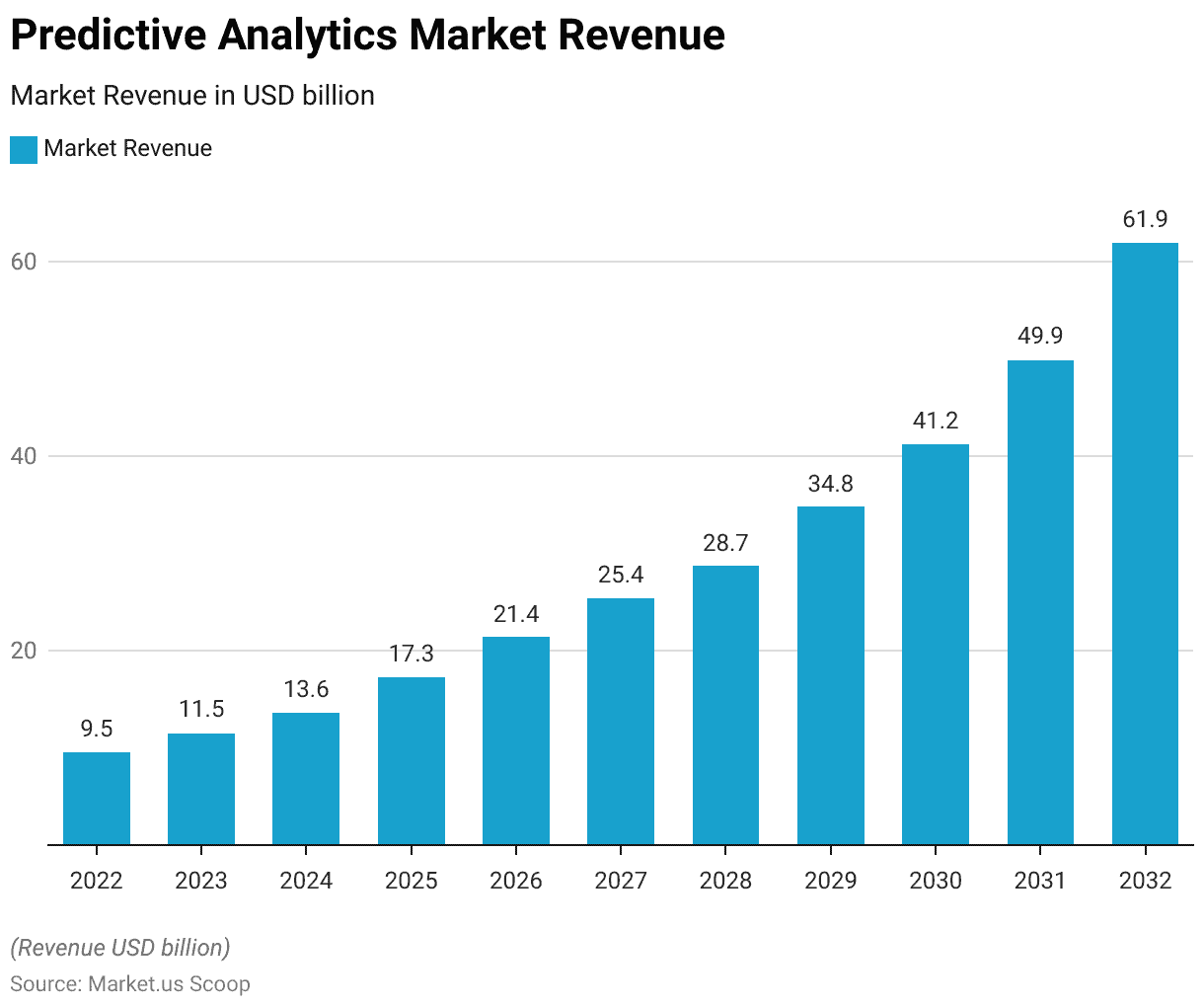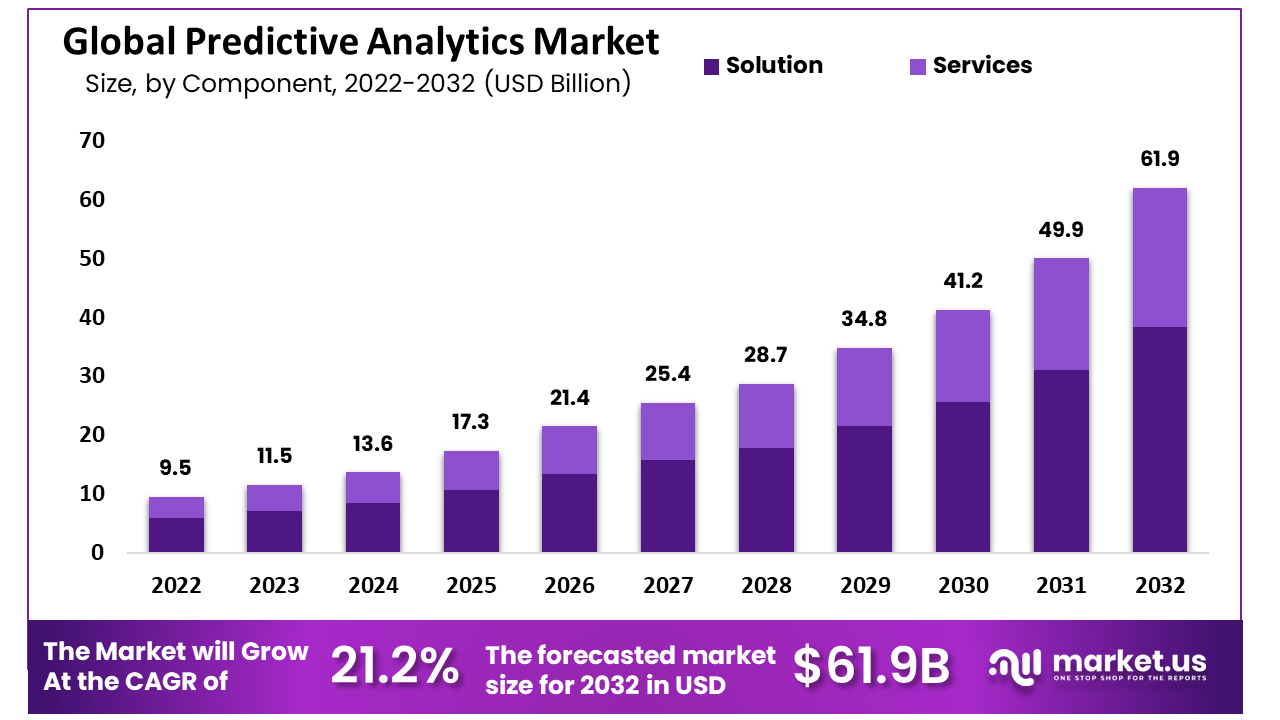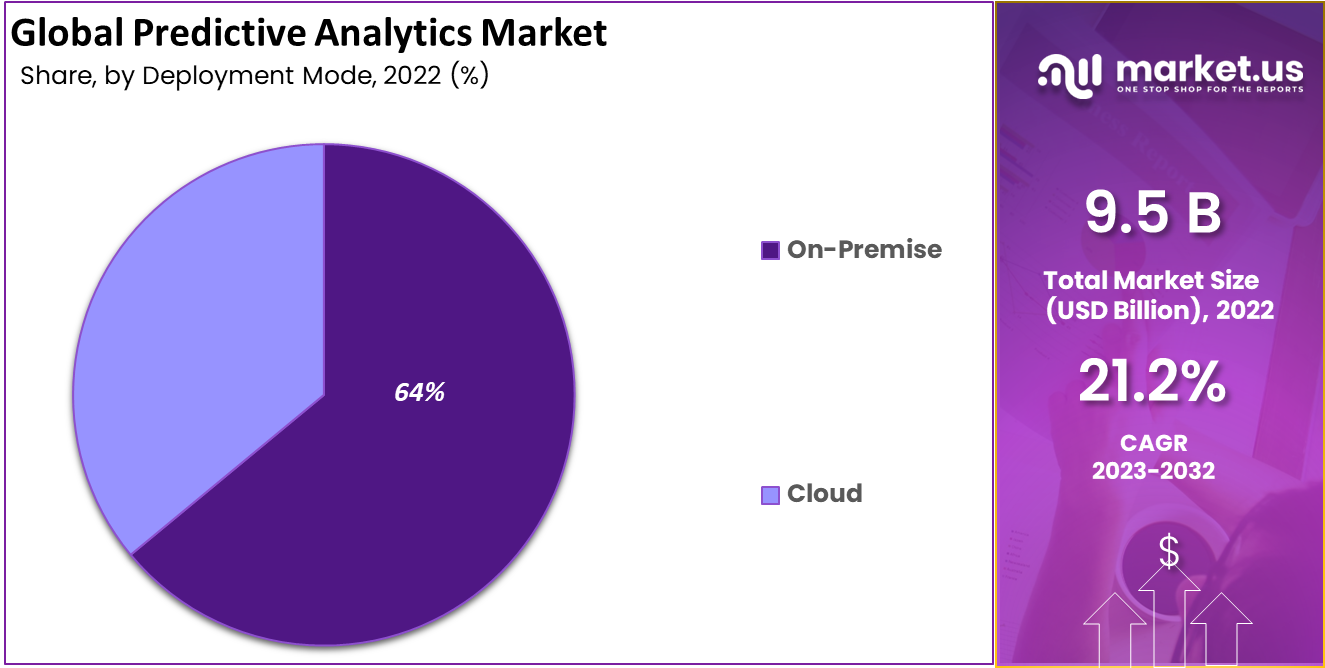Table of Contents
Introduction
According to Predictive Analytics Statistics, Predictive analytics relies on past data and statistical models to anticipate future developments or patterns. It encompasses data gathering, model training, performance assessment, and real-time implementation.
This approach has practical uses across industries like finance, healthcare, and marketing, including tasks like identifying fraud and predicting demand. Ethical concerns, including safeguarding data and ensuring fairness, are crucial. Predictive analytics evolves alongside technological progress and the incorporation of big data and IoT, influencing its future direction.
Editor’s Choice
- The predictive analytics market is poised for significant growth over the next decade at a CAGR of 21.2%, as indicated by the projected revenue figures.
- In 2022, the market was valued at $9.5 billion, and it is expected to steadily increase in the coming years.
- In 2023, the total market revenue is expected to jump to USD 11.5 billion, with solutions revenue remaining at USD 7.0 billion and services revenue holding steady at USD 4.0 billion.
- On-premises deployment holds a dominant position, representing the majority with a market share of 64%.
- In the year 2022, an impressive 72% of these leaders believed that predictive analytics would lead to enhancements in health outcomes, suggesting that the ability to predict and prevent health issues could result in better patient health overall.
- In a survey conducted, 64% of respondents highlighted the improvement in efficiency and productivity as a key advantage of their endeavors.
- Foremost among these is the concern over data privacy and security, which was cited by 49% of participants as a significant obstacle.
Predictive Analytics Market Overview
Global Predictive Analytics Market Size
- The predictive analytics market is poised for significant growth over the next decade at a CAGR of 21.2%, as indicated by the projected revenue figures.
- In 2022, the market was valued at $9.5 billion, and it is expected to steadily increase in the coming years.
- By 2023, it is estimated to reach $11.5 billion, marking a notable uptick.
- The predictive analytics market is projected to surpass the $49.9 billion mark in 2031 and continue its remarkable growth trajectory, reaching $61.9 billion in revenue by 2032.

Global Predictive Analytics Market Size – By Component
- In 2022, the market exhibited promising figures, boasting a total revenue of USD 9.5 billion. This revenue was divided into two key components: solutions and services.
- Solutions, which encompass advanced analytical tools and software, accounted for USD 6.0 billion, while services, encompassing implementation, consulting, and management, contributed an additional USD 4.0 billion to the market’s revenue stream.
- As we look ahead to the future, the market is projected to experience robust expansion. In 2023, the total market revenue is expected to jump to USD 11.5 billion, with solutions revenue remaining at USD 7.0 billion and services revenue holding steady at USD 4.0 billion.
- As a result, the solutions segment is expected to see significant expansion, reaching USD 38.0 billion in revenue by 2032, reflecting the growing demand for advanced data analytics tools.
- Moreover, the services segment is also set to experience steady growth, as businesses seek expert assistance in implementing, customizing, and managing predictive analytics solutions to suit their specific needs.
- By 2032, services revenue is projected to reach USD 24.0 billion, highlighting the integral role of specialized expertise in the successful deployment of predictive analytics.

Predictive Analytics Market Share – By Deployment Mode
- In the global predictive analytics market, deployment modes play a crucial role in determining the landscape.
- On-premises deployment holds a dominant position, representing the majority with a market share of 64%.
- This traditional approach involves hosting predictive analytics solutions within an organization’s infrastructure, offering complete control over data and processes.
- In contrast, cloud-based deployment accounts for 36% of the market share, reflecting the growing popularity of cloud solutions.

Useful Predictive Analytics Tools
SAP Analytics Cloud
- SAP is a major multinational software corporation originating from Germany in the 1970s.
- Their core expertise lies in Enterprise Resource Planning (ERP), and they offer a range of robust data platforms.
- SAP Predictive Analytics, once their primary data analytics tool, is now being integrated into SAP’s comprehensive Cloud Analytics platform.
- For Business Intelligence, SAP Analytics Cloud starts at $22.00 per user per month.
RapidMiner
- RapidMiner has its roots in the AI department of the Technical University of Dortmund and was established in 2006.
- Today, it offers two main products: RapidMiner Go and RapidMiner Studio.
- The platform is user-friendly, featuring a quick drag-and-drop interface. Users have access to a library containing more than 1,500 algorithms to apply to their data.
- RapidMiner Studio offers a free version, while the Professional version is priced at $7,500 per user per year, and the Enterprise version costs $15,000 per user per year.
- For RapidMiner Go, pricing starts at $10 per month.
Alteryx
- Formerly known as SRC LLC, Alteryx underwent a rebranding in 2010 and is now recognized as a leader in data science and machine learning according to Gartner’s Magic Quadrant.
- Alteryx’s primary offering is the APA platform, which stands for Analytic Process Automation.
- Alteryx offers various packages, with Alteryx Analytics Hub available at a rate of $72,000 per year.
IBM SPSS
- IBM, short for International Business Machines, is a renowned technology company. Among its offerings is SPSS, a statistical solution introduced in 1968.
- SPSS specializes in advanced statistical analysis through two main modules: SPSS Statistics and SPSS Modeler.
- SPSS Statistics primarily focuses on predictive analytics, encompassing ad hoc analysis, hypothesis testing, and geospatial analysis for precise data insights.
- Pricing starts at $99 per user per month for IBM SPSS Statistics and $499 per user per month for IBM SPSS Modeler.
TIBCO Spotfire
- TIBCO Spotfire offers a suite of tools designed for handling extensive datasets. When it comes to predictive analytics, it stands out for its user-friendly approach, making it accessible to all.
- Spotfire features “one-click predictions,” which are pre-programmed methods for data classification, clustering, relationship visualization, and forecasting.
- TIBCO Spotfire offers a free version, with premium plans available at $25, $65, or $125 per month.
H2O.ai
- H2O.ai, originating from Silicon Valley, is a notable open-source platform that serves a wide range of business intelligence needs.
- It has gained substantial recognition, with nearly half of Fortune 500 companies utilizing its products.
- H2O.ai offers a diverse set of products, leveraging the power of artificial intelligence and machine learning.
Benefits of Predictive Analytics in Healthcare
- Firstly, an impressive 72% of these leaders believed that predictive analytics would lead to enhancements in health outcomes, suggesting that the ability to predict and prevent health issues could result in better patient health overall.
- Similarly, another 72% expressed their optimism about the positive influence of predictive analytics on patient experience, emphasizing the importance of personalized and efficient healthcare delivery.
- Moreover, 70% expected improvements in staff experience, indicating that predictive analytics could streamline clinical processes, making them more manageable and effective for healthcare professionals.
- From a financial perspective, 69% of healthcare leaders foresaw a reduction in the cost of care, potentially resulting from the early identification of health issues, thus reducing the need for costly treatments.
- Additionally, 69% of respondents believed that predictive analytics would play a pivotal role in population health management, helping healthcare organizations better allocate resources and plan interventions.
- Addressing social concerns, 68% believed that predictive analytics could contribute to tackling health inequality, potentially by identifying disparities in healthcare access and outcomes, thus enabling targeted interventions to bridge these gaps.
- Lastly, 67% saw the potential of predictive analytics in advancing the adoption of value-based care practices, which prioritize the quality of care over the quantity of services provided.

Benefits Companies Get from Using Analytics
- In a survey conducted, several notable benefits emerged from the responses of participants.
- A significant 64% of respondents highlighted the improvement in efficiency and productivity as a key advantage of their endeavors.
- Moreover, 56% emphasized the ability of predictive analytics to facilitate faster and more effective decision-making processes.
- Additionally, 51% acknowledged the positive impact on financial performance, showcasing the potential of predictive analytics to drive better fiscal outcomes.
- Beyond these financial aspects, 46% saw the potential for identifying and creating new revenue streams through innovative products and services.
- This finding aligns with the perspectives of another 46% who recognized the role of predictive analytics in enhancing both customer acquisition and retention efforts.
- Furthermore, 44% emphasized its contribution to improving customer experiences, underscoring its importance in delivering satisfaction and loyalty.
- Lastly, 43% highlighted the competitive advantage gained through the strategic use of predictive analytics, affirming its significance in staying ahead in a rapidly evolving business landscape.

Barriers to the Effective Use of Analytics
- The effective utilization of analytics faces several notable barriers, as indicated by survey respondents.
- Foremost among these is the concern over data privacy and security, which was cited by 49% of participants as a significant obstacle.
- A substantial 33% highlighted the limitation in accessing data as a hindrance to effective analytics implementation.
- In addition, 29% pointed to a deficiency in training as a barrier, indicating a need for skill development.
- Furthermore, 28% expressed challenges with user-friendly solutions, emphasizing the importance of intuitive tools.
- Issues related to technology were also prevalent, with 26% citing a lack of proper technology and 24% indicating a deficiency in analytics technology within organizations.
- Other barriers included the absence of a centralized tool for data capture and analysis (21%) and a lack of executive focus on analytics use (20%).

Discuss your needs with our analyst
Please share your requirements with more details so our analyst can check if they can solve your problem(s)



